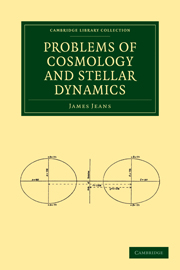Book contents
- Frontmatter
- Preface
- Contents
- I Introductory Chapter
- II General Dynamical Principles
- III Ellipsoidal Configurations of Equilibrium
- IV The Gravitational Potential of a Distorted Ellipsoid
- V Pear-shaped Configurations of Equilibrium
- VI Motion when there are no Stable Configurations of Equilibrium
- VII The Motion of Compressible and Non-homogeneous Masses
- VIII The Evolution of Gaseous Masses
- IX The Evolution of Rotating Nebulae
- X The Evolution of Star-Clusters
- XI The Evolution of Binary and Multiple Stars
- XII The Origin and Evolution of the Solar System
- Index
- Plate section
III - Ellipsoidal Configurations of Equilibrium
Published online by Cambridge University Press: 05 October 2010
- Frontmatter
- Preface
- Contents
- I Introductory Chapter
- II General Dynamical Principles
- III Ellipsoidal Configurations of Equilibrium
- IV The Gravitational Potential of a Distorted Ellipsoid
- V Pear-shaped Configurations of Equilibrium
- VI Motion when there are no Stable Configurations of Equilibrium
- VII The Motion of Compressible and Non-homogeneous Masses
- VIII The Evolution of Gaseous Masses
- IX The Evolution of Rotating Nebulae
- X The Evolution of Star-Clusters
- XI The Evolution of Binary and Multiple Stars
- XII The Origin and Evolution of the Solar System
- Index
- Plate section
Summary
The best-known configurations of equilibrium of a rotating homogeneous mass, namely Maclaurin's spheroids and Jacobi's ellipsoids, are both of the ellipsoidal form, and this form will prove to be of primary importance in all the cosmogonical problems we shall attempt to solve. We accordingly devote a chapter to the subject of ellipsoidal configurations.
Looked at merely from the point of view of convenience in the development of the subject, the ellipsoidal form has the advantage that the potential of an ellipsoidal mass is known and is comparatively simple, and that the ellipsoidal configurations provide admirably clear examples of Poincaré's theory of linear series and stability. These reasons alone might justify our studying ellipsoidal configurations in some detail, but there are weightier reasons, as we shall soon see.
Throughout this chapter and the three succeeding chapters the matter under discussion will be supposed homogeneous and incompressible; the more complicated problems presented by non-homogeneous and compressible masses will be attacked in Chapter VII.
We shall deal in turn with three distinct problems–the first, that of a mass of liquid rotating freely under its own gravitational forces; the second, that of a mass devoid of rotation but acted on tidally by another mass; the third that of two masses rotating round one another and acting tidally on one another.
Information
- Type
- Chapter
- Information
- Problems of Cosmology and Stellar Dynamics , pp. 35 - 64Publisher: Cambridge University PressPrint publication year: 2009First published in: 1919
